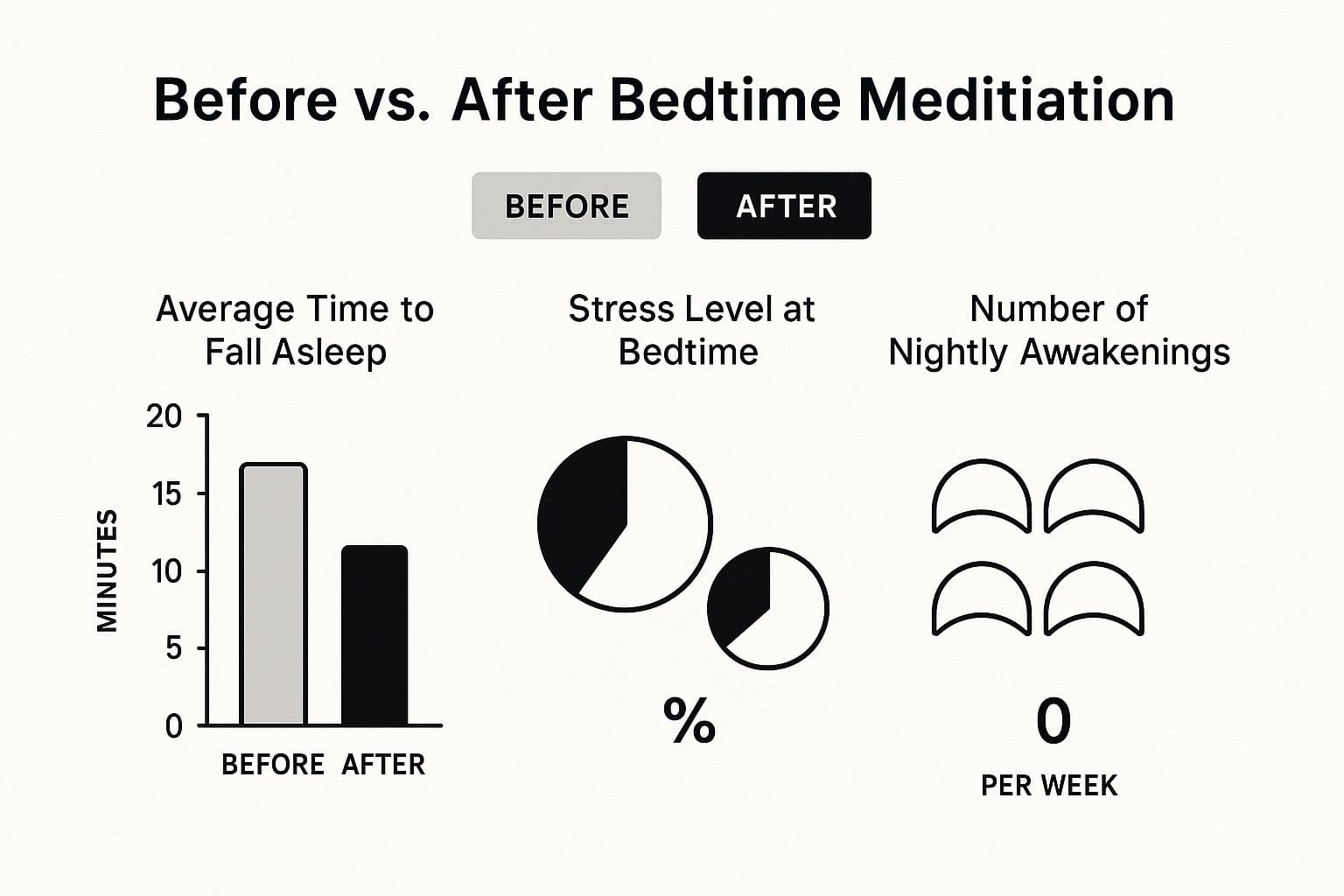Bedtime Meditation for Adults to Sleep Soundly
Tired of a racing mind at night? Discover practical bedtime meditation for adults with simple breathing techniques and calming stories to help you finally rest.
If a racing mind is the reason you’re staring at the ceiling at night, you’re in good company. Bedtime meditation for adults isn't some mystical practice; it's a real, practical tool that calms your nervous system and breaks the cycle of anxiety that keeps you from getting the rest you need. It’s all about using simple, concrete techniques to signal to your body that it's finally time to power down.
How Meditation Helps You Reclaim Your Sleep
Ever lie down after a long day, only for your brain to kick into overdrive? One minute you’re exhausted, the next you’re replaying conversations, building mental to-do lists, or stressing about tomorrow. That mental “noise” is what keeps your nervous system on high alert, making it almost impossible to drift off into the deep, restorative sleep you desperately need.
This is where bedtime meditation steps in. It works by giving your mind a gentle, quiet anchor.
The goal isn't to force your thoughts to magically vanish—that’s a recipe for frustration. Instead, you're just shifting your focus away from the mental chatter. By concentrating on your breath, a guided story, or a soothing sound, you give your brain a new, less stressful job to do. This simple act of redirection is surprisingly powerful. It helps lower your heart rate, relax your muscles, and flips the switch on your body’s "rest and digest" response.
The principle is pretty straightforward: where your attention goes, your energy flows. By moving your attention from anxious thoughts to a neutral anchor, you cut off the fuel that anxiety needs to keep you awake.
This shift isn't just a mental trick; it has very real physical benefits that pave the way for better sleep. To make it even more effective, many people find that combining meditation with calming ambient sounds creates a completely immersive experience. If that sounds interesting, you might want to check out our guide on using wind noise for sleep to help block out distractions and deepen your relaxation.
What Bedtime Meditation Actually Does for You
Let's break down the tangible benefits. This isn't just about "feeling calm"—it's about creating real, physiological changes that promote better rest. Here’s a quick look at what adding meditation to your nightly wind-down routine can do for you.
Benefit | How It Helps Your Sleep |
Lowers Heart Rate | A slower heart rate is a key physical sign that your body is moving out of "fight or flight" mode and into a state of rest. |
Reduces Cortisol | Meditation helps decrease the production of the stress hormone cortisol, which can otherwise keep you alert and wired. |
Calms the Nervous System | It activates the parasympathetic nervous system (the "rest and digest" system), counteracting the overactive sympathetic system (the "stress" system). |
Improves Focus | By training your mind to focus on an anchor (like your breath), you strengthen your ability to dismiss intrusive, sleep-stealing thoughts. |
Ultimately, these small changes work together to create an internal environment where sleep can happen naturally, without a fight.
The growing popularity of this practice really speaks for itself. Meditation is no longer a niche activity but a mainstream tool for mental wellness. In the U.S. alone, the number of adults practicing it shot up from just 4.1% in 2012 to 14.2% in 2017. This huge jump shows just how many people are finding real relief through these simple, accessible techniques.
Crafting Your Perfect Sleep Environment

Before you even think about starting a bedtime meditation for adults, the room around you is already talking to your brain. You don't need a total remodel to get it right; it’s the small, intentional tweaks that signal to your body that it’s time to power down. Your bedroom can either be your partner in rest or your biggest obstacle.
Think of it as setting the stage. If your room is too bright, noisy, or stuffy, your meditation is going to feel like an uphill climb from the start. Getting this piece right makes every other step—from breathing exercises to listening to guided stories—so much more powerful.
The Digital Sunset Ritual
One of the best habits you can build for better sleep is what I call the "digital sunset." It's simple: put away all your screens—phone, tablet, laptop, you name it—at least 30-60 minutes before you want to be asleep. The blue light blasting from these devices is famous for messing with melatonin, the exact hormone your body needs to feel drowsy.
Putting your phone away before bed is more than just avoiding blue light. It's about drawing a line in the sand. This one small action tells your brain, "The day is done, the worries can wait." It creates the mental space you need for genuine relaxation to begin.
Getting the Light and Temperature Just Right
Once the screens are dark, it's time to dial in the physical space. The goal here is a cool, dark, quiet sanctuary. A cave, but cozier.
Cool It Down: A cooler room helps you fall asleep faster. Most sleep experts point to a sweet spot around 65°F (18.3°C). This is because a slight drop in your core body temperature is a natural trigger for sleep.
Embrace the Dark: Use blackout curtains or a good eye mask to get rid of any light pollution. You'd be surprised how much even a sliver of light from a streetlamp or an electronic device can disrupt your sleep cycle.
It’s no surprise that the wellness world has caught on to how crucial these rituals are. The global meditation market is booming, with app usage alone hitting $1.39 billion in 2023. This isn't just a trend; it's a reflection of people everywhere looking for real, drug-free ways to get better rest and a clearer mind. You can discover more about the growth of meditation practices and see just how many are turning to these timeless methods.
Simple Breathing Techniques to Calm a Busy Mind
When your thoughts are swirling like a storm, your breath is the anchor. It's the most powerful and immediate tool you have to pull yourself back to solid ground. Instead of just telling yourself to "relax"—a command that rarely works when you're stressed—you can use physical breathing exercises to actively calm your nervous system.
These techniques are a cornerstone of bedtime meditation for adults because they give a restless mind something to do.
The magic here isn't just mental; it's deeply physiological. By consciously slowing your breath, you're sending a direct signal to your brain that it's safe to power down. You're engaging the parasympathetic nervous system—your body's built-in "rest and digest" mode. It's less of a trick and more of a biological command.
The 4-7-8 Breathing Technique
I turn to this one all the time. Sometimes called "relaxing breath," the 4-7-8 technique is incredibly effective for shutting down that pre-sleep anxiety. It feels like a natural tranquilizer. The simple act of counting gives your mind a repetitive, focused task, pulling your attention away from whatever worries are on repeat.
Here’s the rhythm:
First, exhale completely through your mouth. Make a gentle whoosh sound.
Close your mouth and inhale quietly through your nose for a mental count of four.
Now, hold your breath for a count of seven.
Finally, exhale completely through your mouth, making that whoosh sound again, for a count of eight.
Try repeating this cycle just three or four times. The most critical part is that long, eight-second exhale. It fully empties your lungs and triggers a deep sense of relaxation.
Introducing Box Breathing
Box breathing, or four-square breathing, is another simple yet potent technique. It's used by everyone from yoga practitioners to Navy SEALs to keep a cool head under pressure. Its symmetrical, even pattern is incredibly easy to remember and visualize, which makes it perfect for those nights when your mind feels especially chaotic.
Think of it like you're tracing the four sides of a box with your breath. Each side gets an equal, four-second count. This steady, even rhythm is incredibly grounding when everything else feels off-kilter.
The steps couldn't be more straightforward:
Breathe in through your nose for a count of four.
Hold your breath at the top for a count of four.
Breathe out through your mouth for a count of four.
Hold your breath at the bottom for a count of four.
With either of these techniques, the key is consistency. You don't need to practice for hours. Just a few minutes of focused, intentional breathing can dramatically shift your mental state from wired and anxious to calm and ready for sleep.
Using Guided Stories to Escape Nightly Worries
Let’s be honest: sometimes, the advice to “just focus on your breathing” feels impossible. When your mind is really spinning with the day’s anxieties, trying to force it into silence can feel like wrestling a wild animal.
This is where immersive guided stories come in. I’ve found them to be one of the most powerful and effective forms of bedtime meditation for adults, especially on those nights when my brain just won’t switch off.
Instead of trying to empty your mind—a frustrating task for many—you give it a gentle narrative to follow. It could be a walk through an ancient, mossy forest or a journey across a starlit desert. This approach doesn't fight your brain's natural tendency to think; it simply redirects it. By following a story, you gently lead your "monkey mind" away from your worries and toward a place of genuine tranquility.
Why Storytelling Is So Effective
This method works because it engages your imagination in a low-stakes, relaxing way. Think of it as a form of mental misdirection that effectively crowds out intrusive thoughts. Your brain gets occupied with visualizing the scenery, listening to the narrator's calming voice, and softly anticipating what comes next.
Suddenly, there’s just not enough mental bandwidth left for the day’s stress to intrude.
The goal isn’t to suppress thoughts but to replace them. A well-crafted bedtime story gives your anxious mind a beautiful, safe world to explore, making it much easier to let go of real-world concerns and drift into sleep.
A consistent routine of listening to guided stories can make a huge difference. Over time, you'll likely notice real improvements in your sleep.

As the data shows, regular practice can help you fall asleep faster, feel less stressed at bedtime, and wake up less often during the night. It's a simple change that can have a profound impact.
Finding the Right Audio Meditation for You
Not all audio-based meditations are created equal, and what works for one person might not work for another. It's all about finding the style that clicks with your mind. This table breaks down a few popular options to help you figure out where to start.
Audio Style | Best For | Example Scenario |
Guided Imagery | Visual people who can easily picture scenes described to them. | An audio guide asks you to imagine walking on a warm, sandy beach, feeling the sun on your skin and hearing the waves crash. |
Body Scan Meditations | Those who carry physical tension and struggle to relax their bodies. | A narrator slowly guides your attention from your toes up to your head, asking you to notice and release tension in each muscle group. |
Narrative Stories | Anyone with a "busy mind" that resists traditional meditation techniques. | You listen to a fantasy tale about a peaceful kingdom or a historical account of a quiet monastery, letting the plot carry your thoughts away. |
Binaural Beats/Ambience | Listeners who find voices distracting and prefer pure soundscapes. | You listen to the sound of gentle rain falling in a forest, with specific audio frequencies designed to promote a state of calm. |
Ultimately, finding the right narrative is what makes this technique work. Many people find that fantasy tales or nature journeys are particularly calming, but the key is to experiment.
You can explore a variety of expertly crafted audio tales and find great stories for sleep that match your personal taste. The perfect story is one that captures your imagination just enough to help you disengage from your own thoughts, turning your nightly wind-down into a truly welcome escape.
Overcoming Common Meditation Roadblocks

Let's be honest. Starting a bedtime meditation for adults often feels less like a serene escape and more like you’re doing it all wrong. The reality is, especially when you're just getting started, frustration is a completely normal part of the process.
The most common roadblock? The infamous "busy mind." The moment you lie down to relax, your brain decides it’s the perfect time to draft work emails or create a mental grocery list for next Tuesday. This isn't a sign of failure; it’s just what minds do.
Instead of fighting it, try a different tactic. See each thought as a cloud passing in the sky. Acknowledge it without judgment, and then gently guide your focus back to your anchor—your breath, the feeling of the sheets, or the voice in a story. You might do this dozens of times in a single session. That’s not just okay; it’s the whole point.
Dealing With Discomfort and Doubt
Another common hurdle is physical discomfort. An itchy nose, a restless leg, or just feeling awkward in your position can completely derail your focus. The solution is refreshingly simple: give yourself permission to move.
Scratch the itch. Shift your weight. This practice is about compassionate awareness, not rigid, soldier-like stillness.
Then there's the feeling of "failing" at meditation, which is incredibly common. But here's the secret: meditation isn't a test you can pass or fail.
The real win in any meditation session is the act of returning. Each time you notice your mind has wandered and you gently bring it back, you are strengthening your focus muscle. That is the practice.
If you find that just focusing on your breath actually amps up your anxiety, it’s a clear signal to try a different approach. This is where a good story can be a game-changer. Our ultimate guide to bedtime stories for adults explores how engaging tales offer a welcome escape hatch for a restless mind.
To troubleshoot your own practice, here are a few gentle solutions for common issues:
Racing Thoughts: Simply label them as "thinking" and guide your attention back to your breath or story.
Physical Discomfort: Mindfully adjust your body until you feel more at ease.
Falling Asleep: For bedtime meditation, this isn't a problem—it's a success! It means the practice did its job.
Impatience or Boredom: Start small. Try for just 5-10 minutes and gradually add more time as you feel ready.
Remember, consistency trumps perfection every time. Just showing up, even for a few minutes on a tough night, is what builds the habit and delivers the peaceful results you’re looking for.
Of course. Here is the rewritten section, crafted to sound like it was written by an experienced human expert, following the provided style guide and examples.
Your Questions on Bedtime Meditation Answered
As you get ready to start, a few practical questions might pop up. This is perfectly normal. Getting these sorted out is the last little step before you can really dive in and build a confident, effective bedtime meditation practice.
Think of it as a final check-in before you begin your journey toward more restful nights.
How Long Should I Meditate Before Bed?
When you're just starting out, aim for 10-15 minutes. Honestly, that’s the sweet spot. It's long enough to actually quiet your mind but short enough that it doesn’t feel like another chore tacked onto your to-do list.
The real secret here is consistency, not duration. A short, focused session every single night will do you far more good than one long, heroic meditation once a week. If you find yourself enjoying it and wanting more, you can always extend the time. The goal is to create a sustainable habit, not an obligation.
Is It Bad If I Fall Asleep During Meditation?
Not at all—in fact, for bedtime meditation, that's often the whole point!
If you drift off in the middle of a session, it just means the practice worked exactly as it was supposed to. It successfully relaxed your mind and body enough for sleep to take over.
Don't ever worry about "finishing" the meditation. Consider it a win. The purpose was to get you to sleep, and you succeeded.
What If My Mind Is Too Anxious to Meditate?
This is easily the most common hurdle and the very reason most people turn to meditation in the first place. I hear this all the time.
The goal isn't to force an empty, silent mind—that's nearly impossible for most of us. It's about learning to notice when your thoughts have wandered off and gently, without judgment, guiding your focus back again.
This is where guided meditations, particularly story-based ones, are a game-changer. They give an anxious mind a specific, calming narrative to follow, making it much harder for your own worries to take center stage. You’re not fighting your thoughts; you’re just giving them something better to do.
Ready to give your busy mind a welcome escape? Otherworld Tales offers a library of immersive fantasy and mythology stories designed to guide you into a deep and peaceful sleep. Explore our audio tales and mix in calming ambient sounds to create your perfect nightly ritual. Discover your first story tonight at Otherworld Tales.